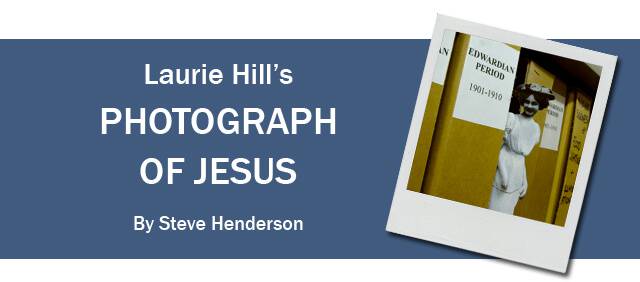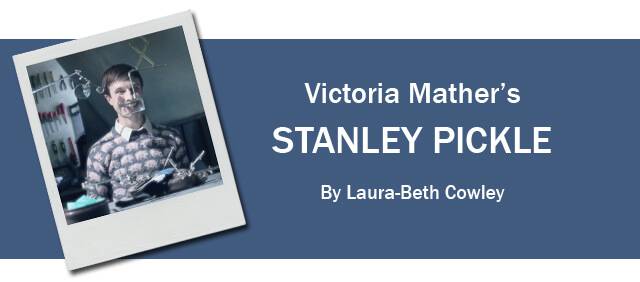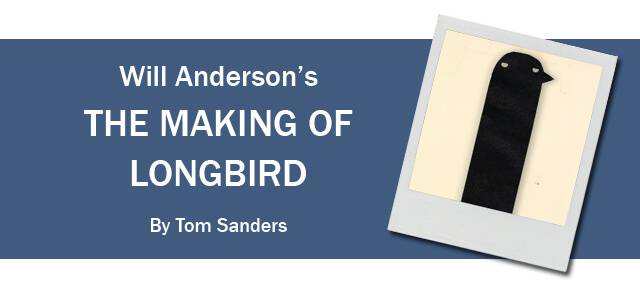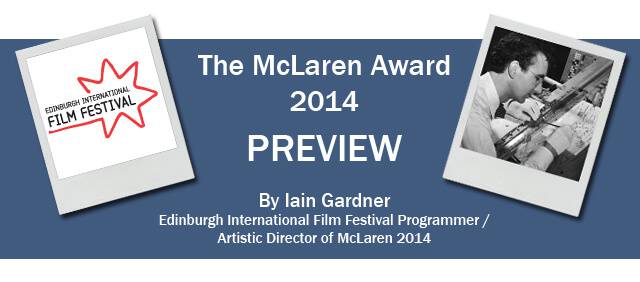25 Years of the McLaren Award 2009-2014
The 24 films that span the timeline of the McLaren award so far are as varied as they are brilliant. No two shorts are alike in style, humour or technique, of course we have a films created in the same medium, but each one takes an independent approach to their medium of choice and creates something new through design, construction or wit. At this years Edinburgh International Film Festival the 25th McLaren award will be handed out to another worthy recipient and whilst we cannot yet peer into the future and see who has won, if previous winners display any pattern it is that a film displaying all the ingenuity and skill of a master of animation will walk away with the award and find themselves worthy of being associated with the name McLaren.
Alongside our final four retro reviews of the award we hear from Iain Gardner, artistic director of McLaren 2014, a celebration of the centenary of McLarens work and the programmer of the animation side of the Edinburgh International Film Festival to get a flavour of this years programme.
 Archives are often perceived as dusty boxes on shelves with little or no everyday use for the public. When I’m not toiling away editing Skwigly, I look after a collection of animation materials and so find the archival process perhaps a little more interesting than the average person. Long before I dipped my toe into the world of archives a few years ago I saw this McLaren award winning film by Laurie Hill. Here is a film that effortlessly makes a seemingly mundane process interesting by adding a human element to a narrative and seeking out interesting stories about weird requests archivists receive. its a good hook, and one that draws the audience in instantly. The title of the short itself is just one of many bizarre requests the Hulton archive get on a daily basis and through pixelation, cutout and stop motion the archive itself and the items available in the collections are put to good use to drive the interview along. the requests for items that defy time and logic are hilariously illustrated through cut out animation and stop motion as Jack the Ripper, Hitler and the yeti run amok through the files and boxes which serves as excellent set dressing for this piece.
Archives are often perceived as dusty boxes on shelves with little or no everyday use for the public. When I’m not toiling away editing Skwigly, I look after a collection of animation materials and so find the archival process perhaps a little more interesting than the average person. Long before I dipped my toe into the world of archives a few years ago I saw this McLaren award winning film by Laurie Hill. Here is a film that effortlessly makes a seemingly mundane process interesting by adding a human element to a narrative and seeking out interesting stories about weird requests archivists receive. its a good hook, and one that draws the audience in instantly. The title of the short itself is just one of many bizarre requests the Hulton archive get on a daily basis and through pixelation, cutout and stop motion the archive itself and the items available in the collections are put to good use to drive the interview along. the requests for items that defy time and logic are hilariously illustrated through cut out animation and stop motion as Jack the Ripper, Hitler and the yeti run amok through the files and boxes which serves as excellent set dressing for this piece.
Archives are so important, you can find literally anything you want in them if you ask correctly, but in most cases they are taken for granted or simply ignored. to see the archival process brought to life in such an interesting way is a joy to behold and like an archive there is something to be found in this film for everyone.
 Simply put, this film is stunning! A cross between film and animation, Vicky’s use of pixilation, imaginative cinematography and beguiling story telling creates this wonderfully surreal but touching story of a boy who doesn’t want to let things die.
Simply put, this film is stunning! A cross between film and animation, Vicky’s use of pixilation, imaginative cinematography and beguiling story telling creates this wonderfully surreal but touching story of a boy who doesn’t want to let things die.
Vicky’s past in photography is used to great effect in her films, the choices of contrasting colours and high impact filters, makes her work pop in a similar vein to the films of Henry Selick or Terry Gilliam. The almost gothic tale follows the life of a very intelligent young boy and the clockwork world he makes for himself. After spending what seems like years with his perfect mechanical parents, Stanley is introduced to a girl, a real breathing living girl, and becomes instantly mesmerized.
This was another great film from the bumper crop of the National film and television school students, and after winning the McLaren award in 2010 the film went on to pick up no less than 33 awards as well as being chosen as an Oscar qualifier in La and part of BAFTA’s Brits to Watch, it was also distributed on iTunes and Amazon before being released online.
I distinctly remembering watching this film in my dingy halls of residence whilst studying for my animation BA, and being entranced by how this film encompassed everything I loved; color theory, taxidermy, an odd, misunderstood but lovable character. The film had a real darkness to it but also an intelligence and softness. For a long time this film was held by myself as experimental film making at its best, now that I have seen and experience more in the way of independent film making this film still ranks as one of my favorites and one I encourage most people I meet to watch.
 The Making of Longbird by BAFTA award winning director Will Anderson is a master stroke and flips the idea of animation on its head. Using an art form that is usually carefully planned and articulated he turns it around to show the disjointed and often up hill struggle of actually making a film. It’s ingenuity and originality is a perfect example of what the McLaren award sets out to celebrate and one that is wholeheartedly deserved of its award.
The Making of Longbird by BAFTA award winning director Will Anderson is a master stroke and flips the idea of animation on its head. Using an art form that is usually carefully planned and articulated he turns it around to show the disjointed and often up hill struggle of actually making a film. It’s ingenuity and originality is a perfect example of what the McLaren award sets out to celebrate and one that is wholeheartedly deserved of its award.
The short follows the journey of director Will Anderson’s desire to bring back and re-invent the genius Vladislav Feltov’s character, Longbird. A master of animation and heralded talent in Russia, Feltov is an enigma and his Longbird creation is currently lost to the world, until now. Mock-umentary style the film is based around the dialogue between Anderson and Longbrid as they try to establish the film’s context and narrative. Used to working for the great Feltov, Longbird is frustrated with this new, young “silly boy”, who appears to be quite literally winging it. As the film continues Anderson’s directions become more and more absurd as it slowly dawns on him that there is no chemistry with Longbird who is increasingly stuck in the past, with no real want of reinvention.
Deconstructing an animated film in this way is a tough task and Anderson along with fellow writer Ainslie Henderson pull it off with unique talent. The combination of live action and animation brings a great dynamic that allows you to quickly lose yourself in this fictional world. The conversational style and sudden physical interactions bring a further level of the illusion of life, that animation has the power to achieve. They cleverly marry this up with uncomfortable and often unfocused shots that really help bring the viewer to the heart of the conflict. Anderson mentioned that he wanted to make “a personal film which (he) could relate to” and I think he goes beyond that. The making of Longbird seems to be a representation of the constant internal dialogue in most animators heads. The consistent struggle to make an idea work and the realities that not everything does. Longbird is the perfect parallel to the man inside your head and sometimes that man wins and the only way to resolve it is to burn him.
 Since seeing Marilyn Myller at a BAFTA screening back in April 2013, it has been an absolute pleasure to watch it go from festival to festival and award to award. Mikey Please has created another short film returning to his unique and original foam-y style. Marilyn Myller tells the story of a young girl, Marilyn who works hard to create something beautiful, but her dedication to perfection means that any creation imperfect will end with Marilyn’s fist.
Since seeing Marilyn Myller at a BAFTA screening back in April 2013, it has been an absolute pleasure to watch it go from festival to festival and award to award. Mikey Please has created another short film returning to his unique and original foam-y style. Marilyn Myller tells the story of a young girl, Marilyn who works hard to create something beautiful, but her dedication to perfection means that any creation imperfect will end with Marilyn’s fist.
Please’s style and unique originality first shone through with The Eagleman Stag of which Please won the BAFTA for best short animation in 2011. Marilyn Myller and The Eagleman Stag both have similar themes of obsession and human flaws though Marilyn Myller takes a much more unexpected and even humorous ending which is a nice touch and light relief for such a serious subject matter. Marilyn Myller should be incredibly resonate well for any animator, artist or creative out there who has struggled to make “the perfect project” and it is clear from the introduction that Marilyn is also a view of Please himself.
Marilyn Myller boasts a much bigger crew and the scale of the project is a lot larger than The Eagleman Stag. Please has taken his creative skill used in Eagleman Stag and topped it with a much more creative use of light, cinematography and music. With comedian Josie Long voicing Marilyn it is an incredible film and a nice addition to the Please collection.
 Before I begin looking ahead to Edinburgh International Film Festival’s McLaren Award in 2014, I’d like to thank all of Skwigly’s contributors for their reviews of our previous recipients.
Before I begin looking ahead to Edinburgh International Film Festival’s McLaren Award in 2014, I’d like to thank all of Skwigly’s contributors for their reviews of our previous recipients.
Some of those previous winners are in competition again this year, vying for the 25th McLaren Award for Best British Animation supported by the British Council. Daniel Greaves (McLaren winner #8) for his lovely film Mr. Plastimime, which demonstrates his mastery of all forms of animation, has an air of nostalgia in the style of variety practised by the protagonist and the practice of animation from a less digital age. Winner #23 Will Anderson joins creative forces with multi award winning Ainslie Henderson in their tender stop motion film Monkey Love Experiment. Will has also been instrumental to bringing ‘lost’ Polish Animation back to the screen with the discovery of Myszochujek by Kristof Babaski, which makes interesting viewing as a ‘new’ film; oldness and newness are examined by McLaren winner #24 as Mikey Please delights us with a spontaneous burst of kinetic energy called Goodness Newness Oldness Badness.
Other film makers returning to the McLaren Award programme include Ross Hogg and Claire Lamond, both contributing to the rising strength of Scottish Animation. Ross’s hand drawn film Spectators observes the behaviour of football fans; whilst Claire’s poignant stop motion Sea Front tells the story of loss suffered by women during WWI. The Brothers McLeod revisit the previous year in 365 and Bjorn-Erik Aschim of The Line returns with quirky observation in Wallflowers.
We always like to take a punt on upcoming talent from local Edinburgh College of Art Animation department (previous World Premiere’s including Ainslie Henderson’s I Am Tom Moody) and this year we reveal the talent of Thomas Fraser (Avocado), Lewis Bolton (Domestic Appliances) and Mayra Hernández Ríos (Separate Lives); recent Annecy winners can also be enjoyed in Edinburgh with the heart wrenching drama of The Bigger Picture by Daisy Jacobs, and an intriguing triptych of animation inThrough the Hawthorn by Gemma Burditt, Pia Borg & Anna Benner.
The rest of the mix consists of excellent stop motion animation by Effie Pappa (My Stuffed Granny), Christopher Eales & Will Bishop-Stephens (Two Films About Loneliness); collages of memory from Bexie Bush (Mend and Make Do), Stephen McNally (Forgot), Kim Noce (Nest of Stone); traditional 2D from Åsa Lucander (Lost Property), Sharon Smith (A Recipe For Gruel); evocative landscapes from Rob Zywietz (Port Nasty) and Betsy Dadd (Terra Infirma); and absolute madness in Peter Millard’s Fruit Fruit.
All said and done a thorough slice through the rich seam of contemporary British Animation. Here’s to the next 25 years of the McLaren Award! Long may it continue!
25 Years Of The Mclaren Award Articles


